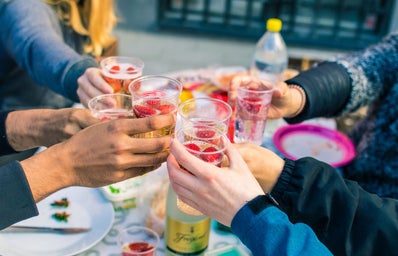The celebration of The first of May must be one of the most confusing festival traditions in Finland. Is the first of May (known as “Vappu” according to Valpuri, whose original name day is May 1) primarily a feast for the working class, academics or farmers? What are the origins and contexts of some of the most well-known Vappu traditions?
In the countryside, the First of May or Valpurin päivä has traditionally been the first day of spring, when the cattle were let out from the barn. This important day came with an assortment of spells to assure success and the safety of the animals. One of these was lighting bonfires to scare off the beasts, but this tradition has since moved to mid-summer. Different beliefs, such as cold weather on Vappu foretelling chill for the whole summer, were popularly practiced. Even small pranks in the style of April fools were popular in rural parishes. This and several other carnivalesque themes have been around since the old days: in Southern Ostrobothnia women dressed up in peculiar clothes and small bells and run around the village while the villagers tried to throw water at them. This was thought to bring good luck with milking the cows.
The First of May is an international holiday for the working class. Until the very end of the 19th century, the day was not particularly celebrated as such, and even the working class mostly rejoiced the start of spring. In 1889, the Second Socialist International announced the day to be an international day for the protests of the workers against different social grievances, such as extremely long working hours. The celebrations politicized in 1890’s and the first political labor marches were organized in Helsinki and Tampere in May 1898. After the Second World War the status of Vappu became stronger and from 1944 on the first of May has been a day off for most of the workers. Different marches, brass bands and sing-alongs have their roots deep in the labor movement.
Everyone knows that Vappu for the students includes student overalls and a lot of sparkling wine. Student caps are regularly used during the Eve and the Day of Vappu, and the beautiful statue of Havis Amanda in Kauppatori in central Helsinki also receives a cap from the students of a selected student association. Especially the engineering students go all out with their humorous Vappu magazines and pranks. But why did the students conquer the celebration of the First of May?
The story behind this is especially interesting: Miss Cajsa Wahllund (1771-1843) was a Swedish restaurateur who owned an inn in Kaisaniemi (named after her!) in central Helsinki. She was very popular among Helsinki students because of her leniency and flexibility with payments. She was a spectacular woman whose business grew thanks to her hard work. After the University of Turku was moved to Helsinki in 1827, the students became her standard customers. The tsar of Russia, Nikolai I, restricted the traditional celebrations of spring, since he was suspicious of the students of Helsinki gathering together. The resourceful students started to celebrate the birthday of their favorite inn-keeper instead! The students gathered in Kaisaniemi to give (patriotic) speeches and sing in the honor of Miss Wahllund and received free drinks from her. The Swedish speaking students continue to gather in Kaisaniemi During Vappu Day.
By the look of it, Miss Wahllund was also serving tippaleipä, a sweet pastry in the style of funnel cake, likely originated in Germany in the Middle Ages. In the 18th century, tippaleipä was served in funerals, and it was a popular festival food and usually enjoyed together with sima in the 19th century. Sima gained popularity specifically as a Vappu drink since it was a non-alcoholic option for booze during the high times of the temperance movement. The special Vappu doughnuts have been part of the coffee servings of the high social class from the 18th century, but it is not known why and how they became Vappu food in particular.
Sources:
https://wiki.aineetonkulttuuriperinto.fi/wiki/Työväen_vappu
http://www.taivaannaula.org/perinne/kansanperinteen-pyhat/vappu/
SKS Biografiakeskus, Cajsa Wahllund: https://kansallisbiografia.fi/kansallisbiografia/henkilo/3280


